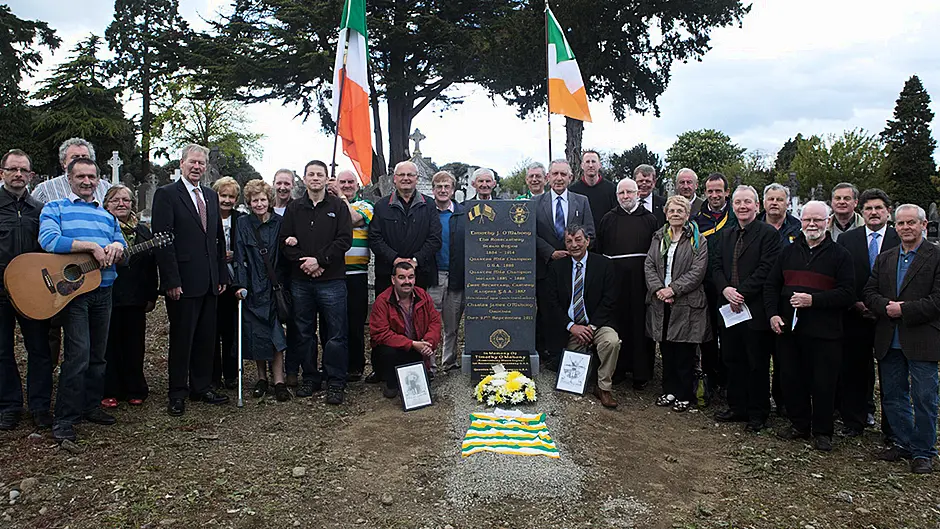The commemoration at Glasnevin of the world champion athlete known as the ‘Rosscarbery Steam Engine’ and its aftermath are recalled by Paul O’Mahony
‘THE locals in Matthews pub in Dublin’s Smithfield area didn’t know what had happened when a busload of Rosscarbery people suddenly descended on their peaceful Saturday afternoon, on May 5th, 2012.
These strangers were in for a few drinks alright, but the songs and the accents were different, from ‘enemy territory’, from Cork, no less! There were some strange looks!
The throng from the Ross included mighty men like Bill Harte, Michael O’Sullivan, Geoffrey Wycherley, Denis McSweeney, Fin Hayes and James Lawlor, and some of the songs that day included the late Denis Hayes’s poignant version of ‘The Carbery Ranger’ and Gearóid Wycherley rendition of a song his grandfather, Geoffrey, wrote, called ‘Our Town Beside the Sea.’
Of course, what had brought the West Corkonians to the capital was a matter of historical importance: the commemoration and, indeed, celebration of a Rosscarbery athlete who conquered all before him in Ireland and then took on the might of the USA’s sports stars, and won.
This happy gathering had just been to Glasnevin cemetery nearly 124 years after TJ O’Mahony became the 400 metres champion of the USA on the GAA’s Gaelic Invasion tour of America. Legendary sports commentator and, unquestionably, the greatest living Kerryman, Micheàl Ó Muircheartaigh, performed the unveiling ceremony of a suitably top-class headstone on O’Mahony’s grave 98 years after the ‘Rosscarbery Steam Engine’s’ premature death at the age of 50 in Smithfield, where he lived in a house on Hendrick Lane beside the pub where the day’s activities culminated in that grand old sing-song.
Culmination
‘It’s not often you have a celebration in a graveyard,’ said Ó Muircheartaigh, delivering the line of the day. ‘The placing of this headstone on TJ O’Mahony’s grave in Glasnevin represents the culmination of a wonderful series of recent events to mark the runner’s achievements,’ he continued.
‘I am delighted to say there were an exceptional number of heartwarming goodwill gestures and financial contributions coming into play to make the day happen for someone who was a proud Irishman and a remarkable champion athlete of the pre-modern Olympic era.’
Indeed, the headstone unveiling marked the final chapter in the ‘campaign’ for recognition for O’Mahony, with direct involvement from GAA headquarters, the Glasnevin Trust, the National Graves Association, Carbery Rangers GAA club and Rosscarbery Community Council. Patrick Barry, the noted Co Cork-based sculptor, did the engraving on stone from a quarry in Kilkenny.
The historical achievements of the great runner had been tracked and traced independently by myself and Michael O’Mahony, from Downeen, of the Rosscarbery Historical Society, so this whole story involved three O’Mahonys with no known family link to each other.
‘In the 1880s, an economically challenging time in Ireland, for “The Rosscarbery Steam Engine” to achieve what he did was remarkable,’ added Ó Muircheartaigh. ‘He is an example to our young people that Irish athletes from even the smallest towns and villages can take on and beat the world’s best.’
US ‘Invasion’
Of course, back in those days, the GAA was actively involved in track and field sports. T.J. O’Mahony was GAA Irish champion in the quarter-mile (400 metres) in 1885, 1887 and 1888 and Irish Amateur Athletics Association (IAAA) champion in 1886, before grabbing all the positive headlines as part of the GAA’s ‘Gaelic Invasion’ tour of the USA in 1888, when some of the country’s finest hurlers and track and field athletes were dispatched to promote Gaelic sports in America.
While hurling proved of great curiosity to the Americans on the unique tour by the 48 Irish sportsmen, it was ‘The Rosscarbery Steam Engine’ – so-called because of his rhythmic running style – who stole the show. The American athletes were the international benchmark on the track at the time and he beat the USA champion in some style, becoming the de facto world champion in an era when there was yet to be a modern Olympics.
This memorable day in Dublin, at Glasnevin and in Smithfield, was the culmination of a series of events celebrating TJ O’Mahony’s achievements. Some seven months earlier, in October 2011, O’Mahony was honoured with a plaque in the centre of his hometown. This was the first official function and again involved Micheàl Ó Muircheartaigh as the star turn, memorably unveiling the plaque on the external wall of the old Carbery Arms in the town’s main square.
What a natural Ó Muircheartaigh proved with the very young children and youth players of Carbery Rangers, who turned out in force to witness the tribute to a man who was also the first secretary of Carbery Rangers and to see the legendary GAA commentator.
Undaunted by the incessant rain, he chatted with so many of them, offering words of enthusiasm and encouragement before officially starting the first ever Rosscarbery Steam Engine 5km Fun Run and Walk, which has raised thousands of euro for charity and other good causes every year since then.
Running club
Furthermore, that moment also served as inspiration for the founding of one of the newest and biggest running clubs in West Cork, the Rosscarbery Steam Runners AC, which boasts an average of about 70 runners of all talents and abilities and who compete in runs big and small all over the country, including sizeable annual events like the Cork and Dublin marathons.
The GAA and its support for the Glasnevin headstone and its unveiling was not its only involvement. In December 2011, a smaller Rosscarbery contingent also travelled to HQ in Croke Park where the GAA Museum took receipt of the only known photograph of TJ O’Mahony for its archives.
In this most unusual year of 2020, one where the celebrations of the 200th anniversary of the Rosscarbery Causeway have, unfortunately, been put on hold for now, one can envisage the scenes in Ross when TJ O’Mahony returned from his tremendous exploits in America, as conjured by the description from The Eagle newspaper in November 1888: ‘On his arrival, the town (Rosscarbery) was brilliantly illuminated, a crowd of about 1,000 persons, of every creed and class, met him outside the town, all anxious to get a glimpse, if not to grasp the hand, of the hero of the hour.’
The Rosscarbery Steam Engine retired sometime later, moving to Dublin where he filed stories as a sports reporter, living in Smithfield, where he was again remembered on that memorable day in Glasnevin in May 2012.
Upon his premature death in September 1914, the writer ‘Carbery’ scripted a memorable tribute: ‘To the younger generation of athletes the “Steam Engine” is only a name, but to the athlete of a quarter of a century ago the pseudonym calls up visions of exciting finishes and heroic deeds on every track from Dublin to Cape Clear and from New York to San Francisco. … his early demise is little less than a national loss.’
In these challenging times, figures like TJ O’Mahony, ‘The Rosscarbery Steam Engine’ – and indeed Micheàl Ó Muircheartaigh himself – serve as examples to us all.









